Difference Between Air Separators and Air/Liquid Separators
Call us at 908.362.9981 to speak with a sales engineer
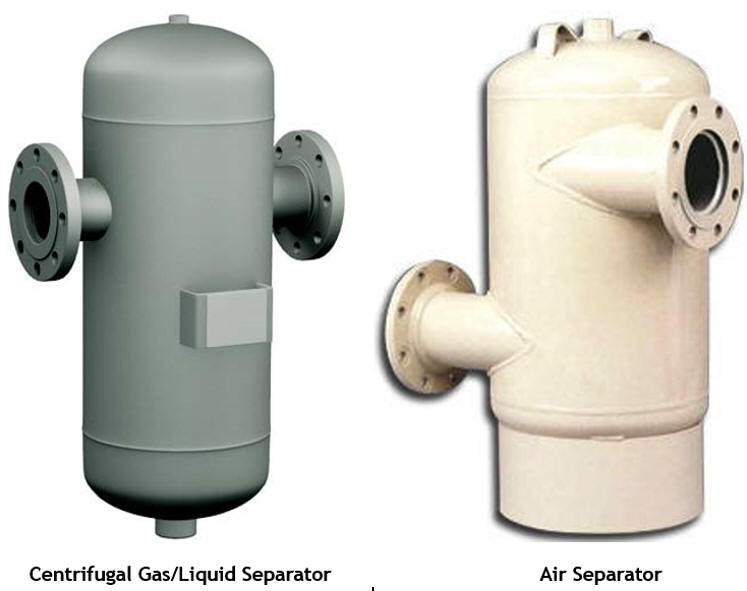 In
modern industrial processes, the efficient separation of gas and liquid
phases is crucial for ensuring system integrity, improving performance,
and preventing equipment damage. Two essential separation devices which
are sometimes confused due to similar names are gas/liquid separators
and air separators; each are designed for distinctly different types of
applications. In this article, we will explore the design principles,
applications, and differences between these distinctly different types
of separators.
In
modern industrial processes, the efficient separation of gas and liquid
phases is crucial for ensuring system integrity, improving performance,
and preventing equipment damage. Two essential separation devices which
are sometimes confused due to similar names are gas/liquid separators
and air separators; each are designed for distinctly different types of
applications. In this article, we will explore the design principles,
applications, and differences between these distinctly different types
of separators.
Centrifugal Gas/Liquid Separators: Design Principle and Applications in Steam Systems
Centrifugal gas/liquid separators, commonly referred to as cyclone separators, play a pivotal role in steam systems by effectively removing entrained condensate droplets and pipe scale from the steam flow. The design principle involves generating a swirling motion causing the heavier liquid droplets to migrate towards the outer walls of the separator while the purified steam flows freely through the central region at a quality of 99.9%.
In steam power plants, centrifugal gas/liquid separators are instrumental in maintaining high steam quality and system efficiency. Steam produced in boilers often contains water droplets, which, if not removed, can lead to erosion and damage in downstream equipment. By deploying gas/liquid separators, power plants can ensure that the steam used to drive turbines and generate electricity is of superior quality, thus safeguarding the turbine blades and enhancing overall plant performance. The most common style of gas/liquid separator for protecting steam turbines is a two-stage coalescing separator which will remove entrained droplets and particles larger than 5 microns with 99% efficiency.
Applications in Non-Steam Systems
Centrifugal gas/liquid separators are also used for many non-steam related applications where gas-liquid separation is crucial for process optimization and equipment protection. As an example, in oil refineries these separators are used to remove liquid droplets from natural gas streams before further processing. This process safeguards downstream equipment from damage and maintains the desired product quality.
Centrifugal gas/liquid separators also play a vital role in chemical processing plants, petrochemical facilities, and natural gas pipelines. Removing liquid particles or droplets from gas streams ensure smoother and more efficient operations, minimize the risk of blockages, and extend the lifespan of equipment.
Example Application in Non-Steam Systems
Calcium Fluoride crystals are utilized during semiconductor manufacturing for microlithography as a flux to protect areas of a silicon wafer from etching. Some of the resulting CaF2 based industrial waste sludge becomes entrained within the air system during the manufacturing process. Centrifugal gas/liquid separators are used to separate the entrained slurry droplets larger than 10 microns with 99% efficiency to enable recovery of the CaF2 waste for use as ingredients in other products.
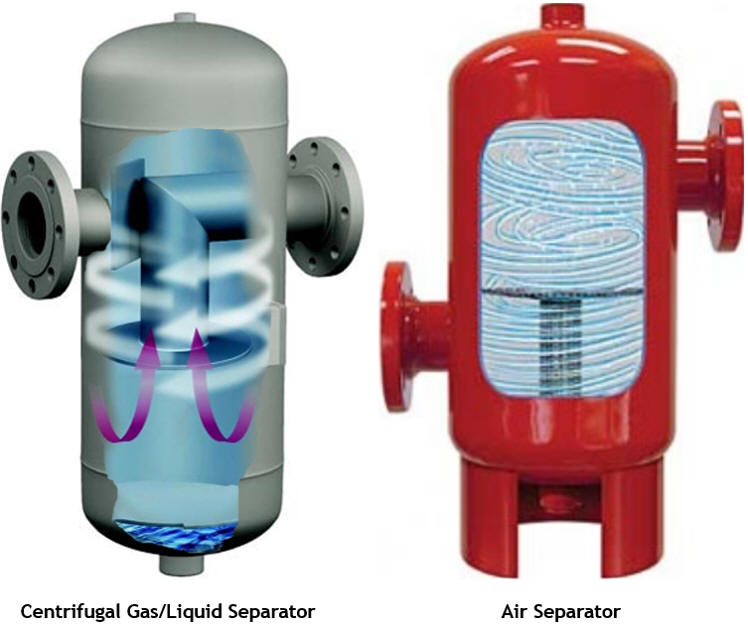 Air
Separators: Design Principle and Applications in
Liquid Systems
Air
Separators: Design Principle and Applications in
Liquid Systems
Air separators, also known as air eliminators, are integral to various liquid systems, such as closed-loop heating and cooling systems, where the efficient elimination of entrained air is paramount. The design principle involves introducing the liquid tangentially into the separator vessel, creating a swirling vortex effect within the unit. Natural centrifugal forces then cause the heavier, air-free liquid to move towards the outer edges, while entrained air is captured by the separator and released to the top. The air is then redirected to the compression tank or vented out of the system through an automatic air vent, such as the Eaton type 90/95-AC air vent trap.
An example application is the use of air separators used in closed-loop heating and cooling systems to ensure bubble-free water flow; such systems are found in commercial buildings, industrial processes, and HVAC systems. Air separators play a crucial role in maintaining system efficiency by efficiently removing entrained air, thus preventing airlock issues, reduce corrosion and improve heat transfer capabilities. The benefits of smooth operation for commercial buildings and HVAC systems is comfortable indoor temperatures. The elimination of entrained air reduces noise and prevents damage to pumps, valves, and other system components.
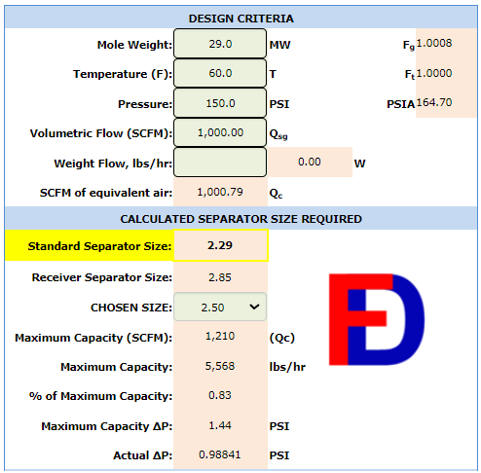 Sizing
and Efficiency
Sizing
and Efficiency
The information required to properly size a gas liquid separator includes the molecular weight of the gas, the design temperature, the minimum operational pressure for which you wish to maintain separation performance and the volumetric or mass flow of the gas with entrained liquid. While additional information is required for the design of the vessel, these 4 data points are sufficient to size the physical vessel in support of 99% separation efficiency. The droplet size separation range is >10 microns to as fine as >1 micron depending upon the specific separator design.
Gas/liquid separators are typically placed close to the equipment or process they are meant to protect.
Although there is quite a bit of math involved to calculate the gas/liquid separator vessel size required, we have automated those calculations with our web-based sizing calculator.
Air separators are sized by calculating the percentage required of the maximum capacity for a given size vessel and plotting that data onto the air elimination efficiency graph.
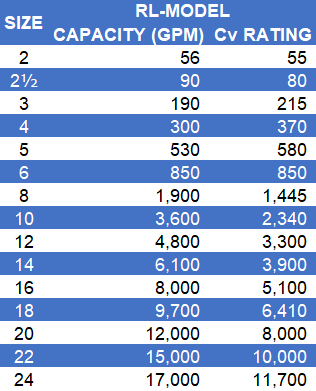 Given
the RL-Model air separation sizing chart, you need to select a vessel
size having a capacity approximately 5-6 times higher than the flow rate
you wish to degas.
Given
the RL-Model air separation sizing chart, you need to select a vessel
size having a capacity approximately 5-6 times higher than the flow rate
you wish to degas.
For example, let’s say that your application uses 350 GPM and you are looking to maximize air separation, choosing an 8" size vessel (having a maximum capacity of 1,900 GPM) equates to using about 18.42% of the total capacity available.
Draw a vertical line from the capacity used (18.42%) and where it intersects with the efficiency curve is the approximate air removal efficiency; continuing with our example, an 8" size air separator vessel would eliminate ≥98.5% of entrained gas with each pass through the unit. In a closed loop system it might require several passes to remove most of the air from your system and thereafter only air attributed to make-up water will need to be removed.
The best location to install an air separator is where the solubility of the dissolved gasses are at their lowest, usually where the liquid temperature is near its highest and the system pressure is at its lowest.
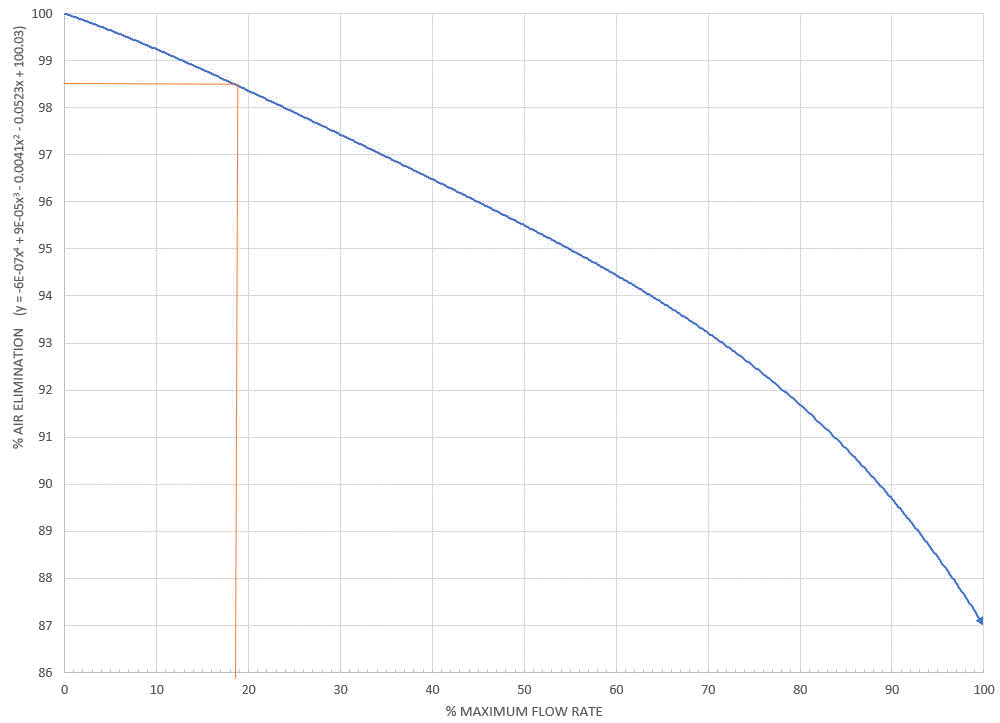
Conclusion
Centrifugal gas/liquid separators and air separators are indispensable components in various industrial applications, each tailored for specific separation needs. Centrifugal gas/liquid separators excel in removing liquid droplets from gas streams, enhancing steam/gas quality and protecting downstream equipment in steam and non-steam environments. Sometimes the entrained liquid or particles can be recycled or are actually the desired product.
Air separators are designed to efficiently remove entrained air from liquid systems, ensuring smooth operation of system components by reducing corrosion and potential of vapor lock; HVAC systems additionally benefit from improved heat transfer efficiency. Air separators are mostly applied to closed loop heating and cooling systems but can also be used for degassing other liquids. While it is possible to greatly oversize a gas/liquid separator to degas a liquid, it is typically far more cost effective to use an air separator vessel.
When selecting the appropriate separator for a specific industrial application, it is crucial to consider the unique requirements and challenges of the process. Both types of separators have their strengths and are optimized for specific tasks. Understanding their differences empowers one to choose the most appropriate separator to a specific application, helping to ensure optimal system performance, reducing operational issues, and enhancing overall efficiency.
Let us put our decades of application experience to work for you! All it takes is a simple phone call or visit to our website, which is filled with information to help you determine your options by comparing several designs. Use web-based tools to quickly judge how process variables affect pressure drop and the physical size of the vessel.
One call is all it takes to speak to someone who
has application experience and is also knowledgeable of product design;
please keep us in-mind for your next application!



